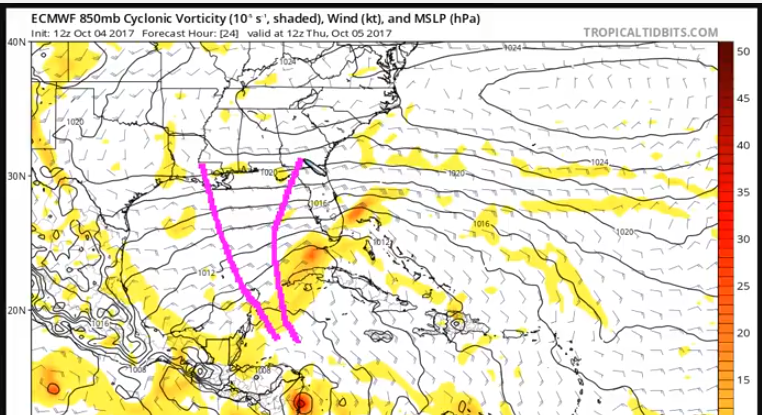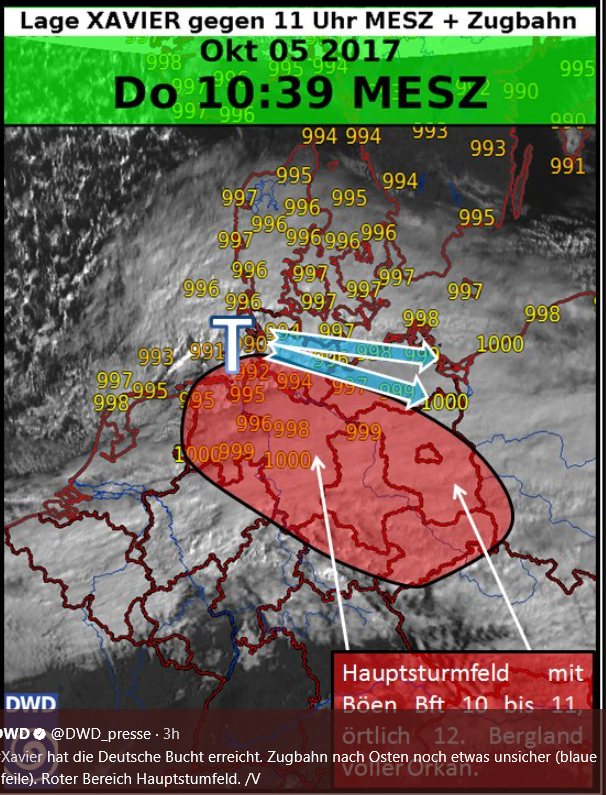Last Wednesday evening, Florida State University graduate student Levi Cowan showed at his Tropical Tidbits site his analysis of what was later to develop into tropical storm Nate in the Gulf of Mexico.
His analysis exposed the great differences – thus huge uncertainty – between the US GFS and the European ECMWF models for the early projected tracks of Nate.
Levi shows the two different model projections below:
In the above figure, the NOAA’s GFS model run takes the storm track over Louisiana (left) while the European showed landfall occurring some 400 miles away to the east at the start of the Florida panhandle (right). If that doesn’t illustrate the huge uncertainty within models, then what does? Source: Image cropped from Tropical Tidbits.
Keep in mind that these two projections for Nate coming from two different models are for just 4 days out, despite being generated by super computers that have been fed with reams of data.
In Levi’s latest analysis here, he shows that the latest storm track now favors the GFS and that the European had been flawed.
Great uncertainty even with forecasts just hours ahead
Meanwhile on Thursday storm Xavier passed through Northern Germany. Mid morning on Thursday the German DWD national weather service tweeted here how the forecast track of the storm over northern Germany over the coming 6 hours was still uncertain!
In the chart above the low pressure system Xavier designated by “T” was centered just over the North Sea just west of Hamburg and moving eastward. The DWD chart above shows the uncertainty of the storm’s projected path with a range of some 150 km upon reaching the Polish border just hours later. Models cannot even predict storm location even 6 hours in advance!
Too much emphasis on models?
Surely meteorologists will be the first to admit that the complexity of storm systems is still far too great to allow predictions of any reliable certainty.
In a recent daily summary at Weatherbell Analytics, veteran meteorologist Joe Bastardi even cautioned against relying too heavily on models, which he said sometimes flip flop between scenarios in just 6 hours. Bastardi feels there has to be greater emphasis on patterns observed over the decades. Already two weeks earlier on September 22 Bastardi warned of a Gulf storm developing between October 1 and October 10. He was right. His forecast was based on patterns, and made long before models sniffed out the storm. Models indeed still have a very long way to go.
If a 6-hour projection is uncertain, then projections out 20 years are worthless
This gives us an idea of what to expect of climate models going out 20, 50 or even 100 years in the future, which woefully lack long-term historical data from major climate drivers such as the oceans, continents, sun and atmosphere. Little wonder that IPCC climate model temperature projections made 10 years ago are already wrong.
But if you happen to be someone who is still sold on the projections made by these climate models, then I’ve got a great deal on a bridge in Brooklyn for you.







The weather is chaotic…im no scientist but I’m pretty sure it’s not possible to predict a chaotic system?? Sure it’s easy to see the big bits, but how can it be possible to account for all the ever smaller fractal components which influence events in their own way??
“I’m pretty sure it’s not possible to predict a chaotic system?”
But if somebody offered you a good, secure living would you try?
Though the alarmists claim otherwise, climate models were never meant to forecast or to even make real world projections but to develop possible scenarios. They are going back all the time now to correct the model inputs based on hind cast because of the errors they make in projection. But while they correct the inputs of the forceings they have built in to make the model hind cast more accurate, they cannot correct the fact that they don’t know all the forceings. You can’t fix what you don’t know about or do know about but do not enter as a forcing in a model. Hell they can’t even identify the sinks where approximately 12% of the carbon goes.
It should be mentioned that in general the European weather model ensemble skill scores are superior to those of the US GFS model. But when it comes to hurricane forecasts the GFS seems to be at least the equal to the European.
As for Joe Bastardi and Levi Cowan, I love what both produce and watch their free stuff every time I can. But both were off in their initial forecasts for the track of TD-16/Nate leading towards the US coast leaning more in agreement with the European than GFS.
The weather is chaotic…im no scientist but I’m pretty sure it’s not possible to predict a chaotic system??
Correct you are Acidohm It just IS NOT POSSIBLE. “chaotic’, random variability with a huge number of variables over a huge area (the surface of the globe).
Even the collection of data from weather stations is fundamentally skewed towards land based stations in heavy and heavier based population locations. E.G. how many readings are taken in the Amazon rain forest compared to say Germany? How many stations are there over the Oceans which represent about 70% of the global surface?
And the fact is that no time has there been adequate surface station coverage in certain regions of the world. In the SH vast areas of the interior of S. America and Africa have no stations reporting regularly. In the N. Hemisphere again the interior of Africa has little coverage as do portions of the ME and a vast area NE Asia. All these areas are infilled by interpolation by Gavin’s team at the GISS to come up with their “hottest year evah” declarations.
I’ve watched these two models and many other for years, overall the GFS tends to be better at short term predictions(3-5 days), the ECMWF better in the medium term (7-10 days) neither can be said to be truly accurate or reliable though.
With long term predictions I have yet to find a model that can reliably predict beyond 10 days with any real accuracy.
Other predictive models like NASA’s El Niño/La Niña has been flip/flopping one way then the other all year, ENSO is
warm,cool,neutral, err, definite umm?… with the AO and NAO???
And on it goes, this year has been particularly poor. It appears that as each month’s newly collected data updates the model, the new output is — oops, all change!
Still what else should to be expected, these model are mostly abstracted numerical curve fitters, modified by encoded guestimations.
A new Judith Curry interview (15:51 duration) on Hurricane forecasting and addressing claims of the alarmists that there will be stronger storms.
https://judithcurry.com/2017/10/06/jc-interview-hurricanes-and-global-warming/